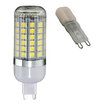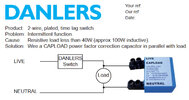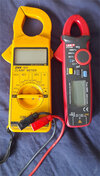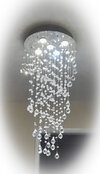I had always thought that the max amount of lamps on a lighting circuit was determined by the total wattage of the lamps not exceeding the max load of the switch.
I am on the last room of the house which i had planned to have controlled by 2nr triple dimmer switches in the following set up
Switch 1 - Study Area
Switch 2 - Living Area
Switch 3 - Kitchen Area
Switcht 4 - Kitchen Feature Light
Switch 5 - Rooflight Feature Light
Switch 6 - Utility
The study and utility are done and working fine. I haven't installed the fittings yet but assume being only 1 fitting and 1 "rope light" to the kitchen & rooflight feature this will also be ok.
I have just connected the kitchen area which consists of 11nr 5w LED downlights (GU10/240v). With all 11 lamps fitted the lights come on and then shut down when on no dim. They all work on half dim or lower. I have removed 3 lamps and the rest seem to work fine. Am I right in thinking if i swap the 5w lamps for 3.5w lamps they will all work fine (8 @ 5w = 40w total / 11nr @ 3.5w = 38.5w total)?
What I cant understand is that the switch is rated at a loading of 5-150w. To me that meant I could have 30nr 5w lamps but clearly this is not the case. How does it work?
The issue i have is that the living area has large number of fittings on the 1 circuit ( i had used the logic above to tell me that 5w lamps would not be an issue no matter how many you have.
My question is - Are there any switches that will operate large numbers of fittings on a single switch? There must be commercial switches that do as office areas surely have large numbers of fittings.
We dot want to reduce the quantity of fittings if we don't have to as this would involve butchering the new ceiling, plus its a large area that we want to have well lit and there are feature areas with multiple fittings. Is there any way round this.
Also is a 3.5w lamp noticeably less bright than a 5w?
I am on the last room of the house which i had planned to have controlled by 2nr triple dimmer switches in the following set up
Switch 1 - Study Area
Switch 2 - Living Area
Switch 3 - Kitchen Area
Switcht 4 - Kitchen Feature Light
Switch 5 - Rooflight Feature Light
Switch 6 - Utility
The study and utility are done and working fine. I haven't installed the fittings yet but assume being only 1 fitting and 1 "rope light" to the kitchen & rooflight feature this will also be ok.
I have just connected the kitchen area which consists of 11nr 5w LED downlights (GU10/240v). With all 11 lamps fitted the lights come on and then shut down when on no dim. They all work on half dim or lower. I have removed 3 lamps and the rest seem to work fine. Am I right in thinking if i swap the 5w lamps for 3.5w lamps they will all work fine (8 @ 5w = 40w total / 11nr @ 3.5w = 38.5w total)?
What I cant understand is that the switch is rated at a loading of 5-150w. To me that meant I could have 30nr 5w lamps but clearly this is not the case. How does it work?
The issue i have is that the living area has large number of fittings on the 1 circuit ( i had used the logic above to tell me that 5w lamps would not be an issue no matter how many you have.
My question is - Are there any switches that will operate large numbers of fittings on a single switch? There must be commercial switches that do as office areas surely have large numbers of fittings.
We dot want to reduce the quantity of fittings if we don't have to as this would involve butchering the new ceiling, plus its a large area that we want to have well lit and there are feature areas with multiple fittings. Is there any way round this.
Also is a 3.5w lamp noticeably less bright than a 5w?





